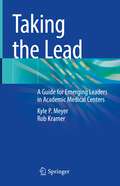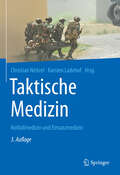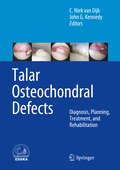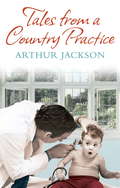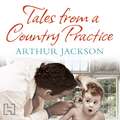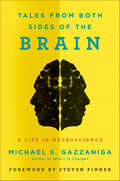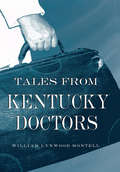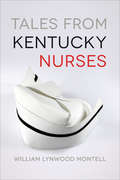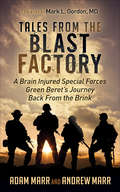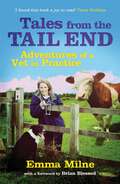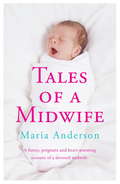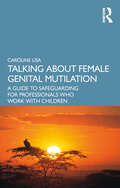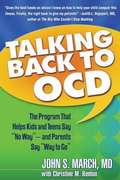- Table View
- List View
Taking the Lead: A Guide for Emerging Leaders in Academic Medical Centers
by Rob Kramer Kyle P. MeyerThis practical, insightful title is a must read for anyone interested in or recently appointed to a leadership role in an academic medical center. Taking the Lead: A Guide for Emerging Leaders in Academic Medical Centers represents the highly accomplished authors’ more than 60 years of collective insights about leadership and leading effectively in an academic medical center environment. The authors present creative and highly applicable themes synthesized from their knowledge, career experiences, unique reflections, practice, mistakes, and observations of successful (and not so successful) leaders. The result is a book of leadership wisdom – a wealth of ideas, concepts, and insights to inform the reader’s career journey and to become the best leader they can be. Organized in five parts, this work examines the successful leadership transition in the unique (and sometimes perplexing) academic medical center environment. Informal, conversational in tone, and often engagingly humorous, Taking the Lead: A Guide for Emerging Leaders in Academic Medical Centers represents a concise and invaluable introductory read for the next generation of leaders, as well as a helpful resource for experienced healthcare leaders.
Taking the World In for Repairs
by Richard SelzerA collection of a dozen short stories, essays, and memoirs originally published in 1986, and now available in trade paperback. Richard Selzer retired as a surgeon in 1984 to write about his profession.
Taktische Medizin: Notfallmedizin und Einsatzmedizin
by Christian Neitzel Karsten LadehofIn dem praxisrelevanten Nachschlagewerk beschreiben ausgewiesene Experten umfassend alle relevanten Aspekte der taktischen Notfallmedizin. Es richtet sich an Soldaten, Polizisten und Angehöriger anderer Behörden sowie der Rettungsdienst-/Hilfsorganisationen und Feuerwehren. Dargestellt werden u.a. die Grundlagen, wie Einsatzplanung, Ausrüstung, Evakuierung sowie die häufigsten Krankheitsbilder- und Verletzungsmuster, wie Schuss- und Sprengverletzungen, Verbrennungen, Augennotfälle und psychisches Trauma. Auch auf die Besonderheiten bei extremen klimatischen Bedingungen sowie das beste Vorgehen bei Verletzungen durch ABC-Waffen geht das Werk ein. Darüber hinaus werden die Rollen von Rettungsdienst, Feuerwehr und Polizei bei besonderen Einsatzlagen beleuchtet und auf die Schnittstellenproblematik zwischen diesen Organisationen eingegangen. Die 3. Auflage erscheint komplett überarbeitet, aktualisiert und um die Themen „Prolonged Field Care“, Crush-Syndrom und Warmblutspende erweitert.
Talar Osteochondral Defects
by C. Niek Dijk John G. KennedyThis book addresses hot topics relating to talar osteochondritis dissecans: improvements in the accuracy of diagnosis, sound preoperative planning, optimal treatment and procedure-specific rehabilitation protocols. The technical difficulties in each of these areas are identified and evidence-based guidelines are presented. With regard to diagnosis, several chapters discuss the roles of arthroscopy, standard radiography, computed tomography, magnetic resonance imaging and combined imaging modalities (PET/CT and SPECT/CT). The chapters on treatment cover various surgical options and provide an overview of the direct postoperative treatment; in addition, rehabilitation protocols are described for all the treatment procedures. The authors are leading experts in the field of foot and ankle surgery who have aimed to provide the reader with an up-to-date handbook ideal for use in clinical practice. Their reviews and opinions are based firmly on the best currently available evidence.
Tales From A Country Practice
by Dr Arthur JacksonWhen the phone rings in the middle of the night, Dr Arthur Jackson leaves the warmth of his bed without hesitation. Tending to his peculiar flock of patients - including the blind cobbler with a surprising taste for hard liquor, the accident-prone butcher and the young woman with an unusual phobia - is his first priority, whether their illness is critical or they simply need a comforting hand to hold. The whole community turns to the young doctor for advice . . . and not all of it medical.Meanwhile, Dr Jackson's family are settling into their new home, a rambling manor house complete with uncooperative ducks and a ghost. This delightfully nostalgic tale follows their progress as the negotiate the highs and lows, the hilarious ups and downs, of life in a country practice.
Tales From A Country Practice
by Dr Arthur JacksonWhen the phone rings in the middle of the night, Dr Arthur Jackson leaves the warmth of his bed without hesitation. Tending to his peculiar flock of patients - including the blind cobbler with a surprising taste for hard liquor, the accident-prone butcher and the young woman with an unusual phobia - is his first priority, whether their illness is critical or they simply need a comforting hand to hold. The whole community turns to the young doctor for advice . . . and not all of it medical.Meanwhile, Dr Jackson's family are settling into their new home, a rambling manor house complete with uncooperative ducks and a ghost. This delightfully nostalgic tale follows their progress as the negotiate the highs and lows, the hilarious ups and downs, of life in a country practice.
Tales from Both Sides of the Brain: A Life in Neuroscience
by Michael S. GazzanigaMichael S. Gazzaniga, one of the most important neuroscientists of the twentieth century, gives us an exciting behind-the-scenes look at his seminal work on that unlikely couple, the right and left brain. Foreword by Steven Pinker.In the mid-twentieth century, Michael S. Gazzaniga, “the father of cognitive neuroscience,” was part of a team of pioneering neuroscientists who developed the now foundational split-brain brain theory: the notion that the right and left hemispheres of the brain can act independently from one another and have different strengths.In Tales from Both Sides of the Brain, Gazzaniga tells the impassioned story of his life in science and his decades-long journey to understand how the separate spheres of our brains communicate and miscommunicate with their separate agendas. By turns humorous and moving, Tales from Both Sides of the Brain interweaves Gazzaniga’s scientific achievements with his reflections on the challenges and thrills of working as a scientist. In his engaging and accessible style, he paints a vivid portrait not only of his discovery of split-brain theory, but also of his comrades in arms—the many patients, friends, and family who have accompanied him on this wild ride of intellectual discovery.
Tales from Kentucky Doctors
by William Lynwood Montell“The book lets us see the human side of physicians—the humorous, the heartwarming—the tradition of health care in Kentucky.” —The Harrodsburg HeraldFrom the laughable to the laudable, Tales from Kentucky Doctors present illuminating portraits of doctors and patients, drawing stories from physicians with lifetimes of experience serving Kentucky families. Doctors recall the successes and failures that shaped their early careers. For Dr. Baretta R. Casey of Hazard, becoming a doctor was a difficult journey. Already married and with a child, Casey enrolled in college at age thirty, later completed medical school, and began a successful career as a family practitioner in the 1990s. Though patient visitations and doctors’ prescriptions are recorded on account ledgers, personal relationships and memories are not part of medical records. The section “Personal Practice” gives a glimpse of the intimate connection that doctors form with their communities. For many towns, family physicians were heroes. Dr. James S. Brashear relates the challenges of practicing in Central City, a coal mining town, recalling an incident in which he saved the lives of two miners. Handed down to Montell in the oral tradition, the tales presented in this collection represent every part of the state. Personal experiences, humorous anecdotes, and local legends make it a fascinating panorama of Kentucky physicians and of the communities they served.“Abounds with interesting and amusing anecdotes about life in rural Kentucky. For those of us who grew up during these times, it brings back fond memories of good times and bad.” —Bowling Green Daily News
Tales from Kentucky Nurses
by William Lynwood MontellThis oral history shares stories of Kentucky nurses—from frontier births to emergency rooms and from the early twentieth-century to the present day. From frontier times to the present day, Kentucky nurses have served with intelligence and energy, always ensuring that their patients received the best available care. Folklorist and oral historian William Lynwood Montell collects nearly two hundred stories from these hard-working men and women in Tales from Kentucky Nurses. From humorous anecdotes to spine-chilling coincidences, tragic circumstances, and heartwarming encounters, the tales in this lively volume are recorded exactly as they were told to Montell. This collection features anecdotes from the famous Frontier Nursing Service, which provided essential care to families in remote areas of the state and whose leader, Mary Breckinridge, is remembered for her wit and kindness. In addition, Montell's interviewees share ghost stories and describe folk remedies like the practice of placing an axe under a woman's pillow during labor to cut the pain. These firsthand accounts not only pay homage to an underappreciated profession but also preserve important aspects of Kentucky's history not likely to be recorded elsewhere.
Tales from the Blast Factory: A Brain Injured Special Forces Green Beret's Journey Back From the Brink
by Andrew Marr Adam MarrA veteran tells his story of suffering from traumatic brain injury—and finally finding relief. Former Green Beret Andrew Marr served multiple tours of duty in Afghanistan—incurring dozens of traumatic brain injuries. It just about destroyed him and his family, and almost cost him his life. After the military medical establishment repeatedly failed him, Marr called upon the initiative and determination that had served him as a warrior—and eventually triumphed with the help of an innovative doctor. As thousands of veterans, athletes, accident victims, and other TBI sufferers wallow in the wake of inadequate treatment—and in many tragic cases, turn to suicide—this book offers new hope and explains the science behind this very specific kind of healing, and why conventional protocols fail. &“Takes us from the battlefields of Afghanistan to Andrew&’s unrelenting battle to be whole again . . . a raw reminder that even in a brain injured state, the mind can clearly triumph.&” —Joe Rogan
Tales from the Tail End: Adventures of a Vet in Practice
by Emma MilneIn 1996, Emma Milne started her first job as a newly qualified vet, a career captured on camera for television’s Vets in Practice. Now she tells the full story. They say that truth is stranger than fiction, and these Tales from the Tail End turn out to be stranger – and funnier – than you could ever have imagined…
Tales from the Tail End: Adventures of a Vet in Practice
by Emma MilneIn 1996, Emma Milne started her first job as a newly qualified vet, a career captured on camera for television’s Vets in Practice. Now she tells the full story. They say that truth is stranger than fiction, and these Tales from the Tail End turn out to be stranger – and funnier – than you could ever have imagined…
Tales of a Midwife
by Maria AndersonMaria Anderson trained as an NHS nurse and went on to become a midwife, a job she has adored for over twenty years. After fainting whilst attending her first three births, Maria went from nervous trainee to assured midwife and in her brilliant memoir she recounts the highs and lows of life inside the maternity unit. From frantic fathers and breaking her hand during a traumatic home birth, to witnessing the delivery of quads and the ultimate devastation of assisting the delivery of a stillborn baby, Maria has had an extraordinary career. Tales of a Midwife is a funny, poignant and heart-warming account of a devoted midwife.
Tales of a Midwife
by Maria AndersonMaria Anderson trained as an NHS nurse and went on to become a midwife, a job she has adored for over twenty years. After fainting whilst attending her first three births, Maria went from nervous trainee to assured midwife and in her brilliant memoir she recounts the highs and lows of life inside the maternity unit. From frantic fathers and breaking her hand during a traumatic home birth, to witnessing the delivery of quads and the ultimate devastation of assisting the delivery of a stillborn baby, Maria has had an extraordinary career. Tales of a Midwife is a funny, poignant and heart-warming account of a devoted midwife.
Tales of a Shaman's Apprentice
by Mark J. PlotkinFor thousands of years, healers have used plants to cure illness. Aspirin, the world's most widely used drug, is based on compounds originally extracted from the bark of a willow tree, and more than a quarter of medicines found on pharmacy shelves contain plant compounds. Now Western medicine, faced with health crises such as AIDS, Alzheimer's disease, and cancer, has begun to look to the healing plants used by indigenous peoples to develop powerful new medicines. Nowhere is the search more promising than in the Amazon, the world's largest tropical forest, home to a quarter of all botanical species on this planet--as well as hundreds of Indian tribes whose medicinal plants have never been studied by Western scientists. In Tales of a Shaman's Apprentice, ethnobotanist Mark J. Plotkin recounts his travels and studies with some of the most powerful Amazonian shamans, who taught him the plant lore their tribes have spent thousands of years gleaning from the rain forest. For more than a decade, Dr. Plotkin has raced against time to harvest and record new plants before the rain forests' fragile ecosystems succumb to overdevelopment--and before the Indians abandon their own culture and learning for the seductive appeal of Western material culture. Tales of a Shaman's Apprentice relates nine of the author's quests, taking the reader along on a wild odyssey as he participates in healing rituals; discovers the secret of curare, the lethal arrow poison that kills in minutes; tries the hallucinogenic snuff epena that enables the Indians to speak with their spirit world; and earns the respect and fellowship of the mysterious shamans as he proves that he shares both their endurance and their reverence for the rain forest. Mark Plotkin combines the Darwinian spirit of the great writer-explorers of the nineteenth century--curious, discursive, and rigorously scientific--with a very modern concern for the erosion of our environment and the vanishing culture of native peoples.
Talking About Female Genital Mutilation: A Guide to Safeguarding for Professionals who Work with Children
by Caroline LisaThis workbook is designed to be used to facilitate discussion and disseminate awareness amongst all professionals (social workers, teachers and health care professionals) who are required by law to report instances of Female Genital Mutilation (FGM). Suitable for use in group settings, it requires no prior knowledge of the subject, but is written in such a way for anyone to be able to facilitate a session with colleagues, which takes between one to three hours depending on the facilitator and group’s needs. Divided into five chapters, it shows how to facilitate a training session using the material, including being aware of how people may be triggered by this difficult subject. Providing activities to facilitate discussion, it explains terminology and provides explanation of different types of FGM, risk factors and legal aspects including mandatory reporting in certain regions. Designed to be concise, it will give busy professionals a quick and effective tool to disseminate information to as many colleagues as possible to allow them to develop understanding of a legal requirement of their job which has real and life-saving benefits for children.
Talking Back to OCD
by Christine Benton John MarchNo one wants to get rid of obsessive-compulsive disorder more than someone who has it. That's why Talking Back to OCD puts kids and teens in charge. Dr. John March's eight-step program has already helped thousands of young people show the disorder that it doesn't call the shots--they do. This uniquely designed volume is really two books in one. Each chapter begins with a section that helps young readers zero in on specific problems and develop skills they can use to tune out obsessions and resist compulsions. Dr. March demonstrates how to Create a nickname for the illness to remember that OCD isn't you Make a symptom chart so you can plan when and where to start talking back Break the disorder's rules about the rituals The pages that follow the instructions for kids and teens show their parents how to be supportive without getting in the way, including tips for Separating the OCD from your son or daughter Asking your child's permission to stop helping with rituals Offering praise without imposing expectations After just a few months' practice, your family will get back to spending time on things that matter, instead of following pointless orders from the illness. The next time OCD butts in, you'll be prepared to boss back--and show an unwelcome visitor to the door.
Talking Back to Prozac: What Doctors Aren't Telling You About Prozac and the Newer Antidepressants
by Peter R. Breggin Ginger Ross BregginA psychiatrist takes a critical look at this SSRI and newer medications that are among the most frequently prescribed drugs in America. Prozac. Millions of Americans are on it. And just about everyone else is wondering if they should be on it, too. The claims of the pro‑Prozac chorus are enticing: that it can cure everything from depression (the only disorder for which Prozac was originally approved) to fear of public speaking, PMS, obesity, shyness, migraine, and back pain—with few or no side effects. But is the reality quite different? At what price do we buy Prozac‑induced euphoria and a shiny new personality? Psychiatrist Peter Breggin, MD, and coauthor Ginger Ross Breggin answer these and other crucial questions in Talking Back to Prozac. They explain what Prozac is and how it works, and they take a hard look at the real story behind today&’s most controversial drug: The fact that Prozac was tested in trials of four to six weeks in length before receiving FDA approvalThe difficulty Prozac&’s manufacturer had in proving its effectiveness during these testsThe information on side effects that the FDA failed to include in its final labeling requirementsHow Prozac acts as a stimulant not unlike the addictive drugs cocaine and amphetamineThe dangers of possible Prozac addiction and abuseThe seriousness and frequency of Prozac&’s side effects, including agitation, insomnia, nausea, diarrhea, loss of libido, and difficulty reaching orgasmThe growing evidence that Prozac can cause violence and suicideThe social and workplace implications of using the drug not to cure depression but to change personality and enhance performance Using dramatic case histories as well as scientific research and carefully documented evidence, the Breggins expose the potentially damaging effects of Prozac. They also describe the resounding success that has been achieved with more humane alternatives for the treatment of depression.Talking Back to Prozac provides essential information for anyone who takes Prozac or is considering taking it, and for those who prescribe it.
Talking Back to Psychiatry: The Psychiatric Consumer/Survivor/Ex-Patient Movement (New Approaches in Sociology)
by Linda J. MorrisonLinda Morrison brings the voices and issues of a little-known, complex social movement to the attention of sociologists, mental health professionals, and the general public. The members of this social movement work to gain voice for their own experience, to raise consciousness of injustice and inequality, to expose the darker side of psychiatry, and to promote alternatives for people in emotional distress. Talking Back to Psychiatry explores the movement's history, its complex membership, its strategies and goals, and the varied response it has received from psychiatry, policy makers, and the public at large.
Talking Men's Health: Understanding and Supporting Men with Long-Term Conditions
by Caroline FlureyThis book explores male health psychology in relation to chronic health conditions. Using data from men with rheumatic diseases as a starting point, this book draws on the wider literature to focus on how men talk about different aspects of living with long-term health issues. This includes how men discuss the impact of chronic illness on their sense of control and self-reliance, masculine identity, body image, mental health, sex and intimacy, and for those living with a life-limiting condition how they discuss facing their mortality. It also covers how men self-manage and what influences their help-seeking behaviours. Whilst men are often branded as ‘hard to reach’, the author argues that when given permission and provided with the right environment, men will talk about their health. This book takes the stance men are under-served by health services and includes suggestions for developing support services for health and mental health that meet men’s needs and preferences. Focussing on the experiences and support needs of men with long-term conditions, this is an ideal reading for clinicians, healthcare professionals, and practitioners working with men with long-term conditions, as well as early career researchers and students interested in male psychology, men’s health, and gender and society.
Talking Points on Deprescribing in Hospice Care
by Deepak ShrivastavaDeprescribing practice in hospice medicine has expanded exponentially in recent years. This book systematically addresses the groups of extremely useful medications to manage chronic disease conditions and prevent complications. It highlights the positive intervention of reducing polypharmacy, improving a terminally ill patient's quality of life, providing individual patient context and helping clinicians in deprescribing. It discusses good ethics, patient wishes and side effect protocols to discontinue no longer relevant medications, thus improving decision-making with the goal of enhancing the patient's quality of life during the time when it is needed the most.Key Features: Empowers the patient, their families, and the providers to have an open discussion about well-informed decision-making. Equips the hospice and palliative care clinicians to comfortably explain the rationale and the discontinuation process of the unessential medications. Highlights the most important facts in bullets along with a unique feature of providing ready-to-go conversational phrases.
Talking Therapy: Knowledge and Power in American Psychiatric Nursing (Critical Issues in Health and Medicine)
by Kylie SmithTalking Therapy traces the rise of modern psychiatric nursing in the United States from the 1930s to the 1970s. Through an analysis of the relationship between nurses and other mental health professions, with an emphasis on nursing scholarship, this book demonstrates the inherently social construction of ‘mental health’, and highlights the role of nurses in challenging, and complying with, modern approaches to psychiatry. After WWII, heightened cultural and political emphasis on mental health for social stability enabled the development of psychiatric nursing as a distinct knowledge project through which nurses aimed to transform institutional approaches to patient care, and to contribute to health and social science beyond the bedside. Nurses now take for granted the ideas that underpin their relationships with patients, but this book demonstrates that these were ideas not easily won, and that nurses in the past fought hard to make mental health nursing what it is today.
Talking about Acupuncture in New York
by J. R. WorsleyThe book is on a seminar given by Professor J. R. Worsley in 1980 to members of the Arica Institute and the public on acupuncture.
Talking with Doctors
by David NewmanWithout any warning, in September 1999, David Newman was told he had a rare and life-threatening tumor in the base of his skull. In the compressed space of five weeks, he consulted with leading physicians and surgeons at four major medical centers. The doctors offered drastically differing opinions; several pronounced the tumor inoperable and voiced skepticism about the effectiveness of any nonsurgical treatment. Talking with Doctors is the story of Newman's efforts, at a time of great stress and even impending death, to wend his way through the dense thicket of medical consultations in search of a physician and a treatment that offered the possibility of survival. It is the story, especially, of the harrowing process of assessing conflicting "expert" opinions and, in so doing, of making sense of the priorities, personalities, and vulnerabilities of different doctors. All too often, he found, the leading specialists to whom he was sent were strangers in the consulting room-and strangers who became stranger still, both cognitively and emotionally, when ambiguous findings pushed them to the outer limits of their training and experience. Newman writes poignantly of his sense of powerlessness and desperation, of the painstaking means by which he ascertained what could be known about his tumor, and of the fortuitous events that finally led him to life-saving help. Talking with Doctors is a compelling, absorbing, unsettling story that touches a collective raw nerve about the experience of doctors and medical care when life-threatening illness leads us to subspecialists at major medical centers. Probing the nature of medical authority and the grounds of a trusting doctor-patient relationship, Newman illuminates with grace and power what it now means for a patient to participate in life-and-death medical decisions.
Talking with Patients About the Personal Impact of Ilness: The Doctor's Role
by Leonore Buckley Dennis J. ShaleThis book explores the psychosocial impact of serious illness - its effect on a person's identity and relationships - and the doctor's role in counseling patients. Even the most seasoned physician often feels inadequate when it comes to discussing the personal impact of disability and serious illness with patients. It takes time, attention, and skill. Most physicians who are good at this learn what to say from observations of physicians they respect and the conversations they share with patients over many years of practice. Like everything else in medicine, there is a continuous learning curve. This book offers a beginning. It includes first-hand experiences and reflections on serious illness by physicians and patients, concrete advice on how to initiate discussions of difficult psychosocial issues, topics for organising discussion, suggested readings, and guides for patient interviews.'Much is written about patient-centered care and the patient experience.What sets this book apart is, first, Lenore Buckley's ability to tell stories about her own medical experience. These teaching tales give young physicians a sense of the task that their profession requires of them, while keeping that task within human proportions. Second and complementing that is her excellent compilation of quotations and stories from the memoirs of patients and physicians, especially physicians as patients. 'I hope this empathic, useful collection of materials for teaching and reflection finds its way into medical school curricula, and I hope it is one of those books that physicians return to during years of practice, especially when they sense that the treatment expert is crowding the witness out of the room. Patients need both doctors. Lenore Buckley shows how doctors are able to expect nothing less of themselves' - Arthur W Frank in the Foreword.
